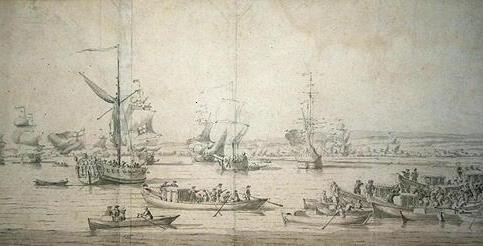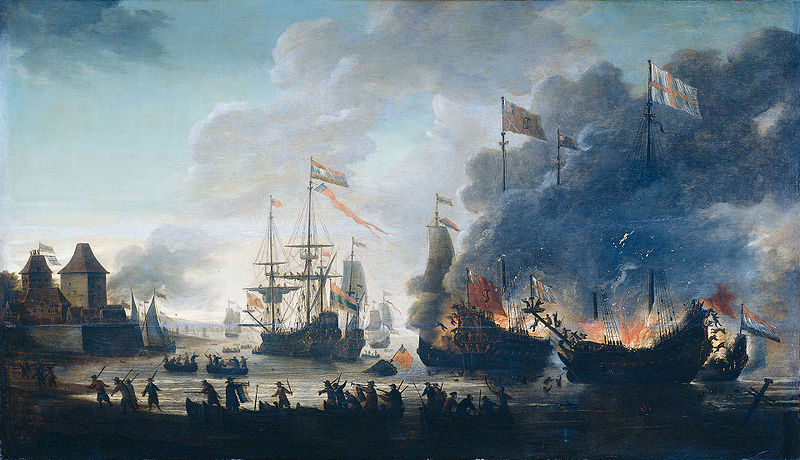James Stewart, second son of Charles I of England, was born in 1633. He was named Admiral of the Navy at age three and created Duke of York in the second year of the English Civil War (1643).
James was taken prisoner by his father's Parliamentry opponents when the city of Oxford fell in 1646. From there he was sent to London. He was held at St James Palace until his escape in April of 1648. He then made his way to Paris where he joined his brother and his mother in their improvished court-in-exile. He was still in France when his father was beheaded at Whitehall, London in January of 1649.
During the twelve year interregnum, James suffered along with his brother. There were few things the royal heir could do while waiting upon his distracted brother - and none of them involved earning a living.
The exiled duke learned during these twelve years of privation that the authority of the English sovereign had to be re-established and preserved. He took his place in his brother's court with a silent commitment to would use the power of his position to secure for the monarch and the monarchy its former preeminence.
Immediately following his brother's Restoration in 1660, James set about implementing a cunning plan.
Using his position as Admiral of the Navy as a platform, James arranged for the creation of an entity called the Company of Royal Adventurers Trading to Africa. This peculiar institution, of which James was the managing director, held a chartered monopoly over England’s slave trade. With the help of his Royal Navy, James established trading posts on the West African coast and zealously defended his business monopoly against intruders into his African trading centers.
While developing his “supply” channel in Africa, James began to promote a second phase of his business plan - war with the Netherlands. England’s powerful seafaring rival controlled the trade routes between Africa and the West Indies that James needed to distribution of his African cargoes. Control of these trade routes would allow the enterprising duke to vastly expoand his market in the sugar islands of the Caribbean.
The third element of James's grand scheme contributed to the success of the second. To build support for war with the Dutch, he arranged for several powerful members of his brother’s privy council to receive a massive new grant of land on the American mainland below the colony of Virginia. The eight beneficiaries of the proprietorship of Carolina were: Edward Hyde (Earl of Clarendon) William, Lord Craven, John, Lord Berkeley, Anthony Ashley Cooper (Earl of Shaftesbury) George Monck (Earl of Albemarle) Sir George Carteret, Sir John Colleton and William Berkeley, younger brother of Lord John.
The war against the Dutch started when Robert Holmes, “admiral" of James’s trading company fleet, attacked Dutch African trading posts in 1664. The Dutch proved to be more than a match for James's navy, but it was a pair of natural calamities that doomed the venture.
In 1665, the plague suddenly erupted in the city of London. As it spread across England's rat-infested capital, a fire broke out that virtually consumed the city. Eighty percent of London‘s houses were destroyed before it finally burned out.
These two catastrophes had a devastating effect on commercial activity throughout the realm. As royal revenues fell, the Admiral of the Royal Navy found it impossible to repair his battered fleet.
The culminating disgrace in this ill-conceived war was against the Dutch
is remembered today as “the disaster at Medway”.
On 20 June 1667, a Dutch fleet sailed brazenly up the Thames River and under the very nose of the conniving Duke of York sacked the Chatham naval base on the Medway Creek. The destruction of the ships at anchor there and the humiliating capture of the "Royal Charles", the pride and flagship of the English fleet, led to a negotiated settlement to the 2nd Anglo-Dutch War. It also led to the dismissal of Lord Clarendon and the suspension of James Stewart repulsive business enterprise.
James was able to resurrect his defunct slave-trading business during the tumult of the 3rd Anglo-Dutch War which began in 1672. He did this by merging the remnant of its first edition with the remains of the Gambia Merchants' Company. The new venture was given the lofty name of the Royal African Company. James was thus able to resume construction of the fortifications and territorial control necessary to pilfer the humanity and wealth of Western Africa.
Prior to his ascension to the English throne in 1685, James’s illicit venture is said to have transported up to 5,000 Africans per year into slavery in the West Indies and the proprietorships on the American mainland. Many of these unfortunates were branded with the letters 'DY', after its chief, the Duke of York. When James took the throne, these marks were changed to the company's initials, RAC.
Between the establishment of the Royal African Company and James’s “abdication in 1688 the RAC is thought to have transported up to 100,000 souls to the New World.







